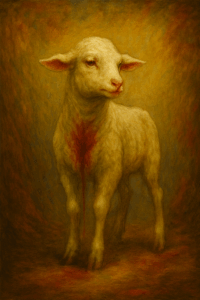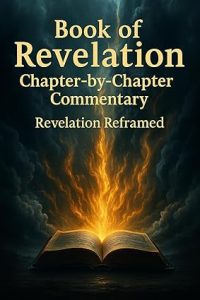A Fresh Perspective on Revelation: Hope Beyond Fear

The Book of Revelation reveals the Lamb who was slain yet stands victorious over worldly powers
Table of Contents
- Unveiling What Has Been Veiled
- The 3 Pillars of Revelation’s Message
- Reframing Our Present
- The Invitation to Remember
- Books to Strengthen Your Faith
- Conclusion
A Fresh Perspective on Revelation: Hope Beyond Fear
They say Revelation was never meant to terrify—but to unveil. To pull back the veil between what is seen and what remains hidden. Between the empires that roar and the Lamb that was slain.
For too long, the Book of Revelation has been weaponized, commodified, and reduced to timelines and tribulations, to escape hatches and end-times charts. But such readings betray the text itself. What if God intended it not as a roadmap to destruction but as a message of comfort and hope? What if Revelation is less about predicting the future and more about reframing the present?
“Blessed is the one who reads aloud the words of this prophecy, and blessed are those who hear it and take to heart what is written in it, because the time is near.” — Revelation 1:3
This blessing—the first of seven in Revelation—isn’t reserved for those who decode its mysteries correctly. It’s for those who allow its vision to transform how they live now, in this moment, under the weight of empires that seem invincible but are already passing away.
The 3 Pillars of Revelation’s Message
Through our exploration of three biblical truths—Ḥesed (steadfast love), Qadosh (holiness), and Berith (covenant faithfulness)—we uncover the true heart of Revelation: not escape from this world, but God’s unwavering commitment to restore and dwell within it.

Understanding these three biblical concepts transforms how we read Revelation
Ḥesed: The Steadfast Love That Never Fails
The Dragon rules from the shadows. And beneath him, the Beast controls everything: speech, loyalty, belief. But the slain Lamb stands. And those who have eyes to see catch glimpses of another kingdom breathing beneath the machinery of empire.
God’s ḥesed—His steadfast love that doesn’t calculate or compromise—remains constant even in times of tribulation. When the seventh seal is opened, there is silence in heaven. When the seventh trumpet sounds, voices cry out, “The kingdom of the world has become the kingdom of our Lord and of his Messiah.” When the seventh bowl is poured out, a voice from the throne declares, “It is done!”
These are not the vengeful declarations of a deity eager to punish, but the faithful fulfillment of covenant promises. The judgment that falls on Babylon is not arbitrary retribution but the inevitable consequence of an empire built on exploitation, deception, and violence.
Revelation reveals how God’s love pursues His people to the very end. The Beast says, “Worship me and I will give you everything.” The Lamb says, “I have given everything for you—remember who you are.”
Kadosh: The Holiness That Unmasks
Throughout Revelation’s vivid imagery runs a golden thread: kadosh, the holiness that doesn’t withdraw from the world’s suffering but enters fully into it. The four living creatures never cease to cry “Holy, holy, holy” even as seals are broken and bowls of judgment are poured out.
This kadosh is not the sterile sanctification of those who isolate themselves from contamination. It is the fierce holiness that confronts the powers by living differently—by embodying covenant faithfulness when everyone else bows to the Beast’s image.
The 144,000 sealed from every tribe do not receive their mark as a ticket out of tribulation. Their sealing marks them as those who remember the covenant when forgetting has become the path of least resistance. They are kadosh not because they are morally perfect, but because they refuse the Beast’s bargain: safety in exchange for worship.
God’s perfect holiness stands in contrast to the broken systems of this world. The Beast appears as the inevitable pinnacle of civilization, clothed in luxury and drunk on the blood of prophets. She seems invincible, eternal, necessary. “Who is like the Beast, and who can fight against it?” ask those who have accepted its framing of reality.
But John’s vision reframes her glory as transient and her wealth as theft. What seems like strength is revealed as desperate weakness. What appears as peace is unmasked as systematic violence maintained through spectacle and surveillance.
Berith: The Covenant That Cannot Be Broken
The final scroll of scripture does not arrive with explanatory footnotes or systematic theology. It comes to us in dreams and visions, in symbols and songs, in thunder and tears. It speaks not in the language of empire, but in the forgotten tongue of covenant—of berith—the ancient promise that binds Creator to creation not through domination, but through ḥesed.
God keeps His promises. Revelation is not an interruption of God’s covenant story but its culmination, showing how He fulfills every promise made to His people. The New Jerusalem descends not as a reward for the morally superior, but as God’s dwelling place with humanity—the fulfillment of berith that began in a garden and continues in a city where the tree of life grows and the river flows freely.
“He will wipe every tear from their eyes. Death will be no more; mourning and crying and pain will be no more.” — Revelation 21:4
This is why Revelation ends not with escapism but with longing: “Come, Lord Jesus.” Not as a plea to be removed from the world’s suffering, but as an invitation for the covenant reality to become fully manifest within history. The prayer recognizes that the Lamb is already present, already standing, already offering living water to those who thirst.
Reframing Our Present Through Revelation’s Lens
At its core, Revelation offers not prediction but reframing. It invites us to see our present reality through covenant eyes—to recognize that beneath the Beast’s carefully constructed narrative lies a deeper truth.
What terrifies the Beast is not armed resistance—which it knows how to crush—but covenant memory that cannot be erased. The regime invests enormous resources in surveillance, propaganda, and public spectacle precisely because it fears what happens when people remember the Lamb.
Eyes that never blink monitor every prayer, measuring devotion in decibels and pupil dilation. The flame is everywhere—projected from towers, engraved into uniforms, dancing on devotional screens. “Peace demands vigilance,” the voice reminds gently. “Report divergent thinking. It is an act of love.”
But Revelation shows us what the Beast cannot acknowledge:
- Its power is derivative, not original
- Its authority is temporary, not eternal
- Its control is illusory, not absolute
- Its wound may seem healed, but remains fatal
The Dragon’s authority is always borrowed, never intrinsic. The Beast’s deadly wound that seemed healed reveals the fundamental vulnerability at the heart of every empire that sets itself against the Lamb.

Revelation unmasks the true nature of worldly power compared to the Lamb’s authority
The Invitation to Remember
They say the silence won’t last forever. There are still a few who remember. They hide in ruins, beneath burned-out sanctuaries and behind encoded hymns. They speak in riddles and fragments, passing down what they can’t write down.
They remember the One who was slain—and yet stands. They remember ḥesed—the steadfast love that doesn’t calculate or compromise. The love that stays when reason fails and power threatens.
And somewhere, far beyond the reach of towers and drones—the Lion draws breath.
Not to devour, but to speak. Not to conquer, but to reclaim. Not with armies and declarations, but with one word that cuts through the Beast’s carefully constructed reality:
“Remember.”
Because the truth doesn’t scream. It waits. It weeps. It breathes like embers in the dark until the wind of remembrance fans it into flame.
Books to Strengthen Your Faith
Deepen your understanding of Revelation through these insightful works that illuminate God’s covenant faithfulness:
Theology of the Lamb
The Book of Revelation is not a code to crack. It’s a person to encounter.
At the center of the world’s most misunderstood book stands the Lamb who was slain—and until we see Him clearly, Revelation will remain a mystery. Theology of the Lamb is your guide to discovering that Lamb, understanding His character, and seeing how His sacrifice reframes everything we thought we knew about power, victory, and love.
Key benefits:
- Discover the central figure of Revelation
- Understand the true nature of divine power
- See how the Lamb redefines victory
- Learn why love is the ultimate revolutionary force
Theology of the Lamb — a theological deep dive
Book of Revelation Chapter by Chapter Commentary
For many, the Book of Revelation is a source of fear—dragons, beasts, bowls, and judgment. But that’s not how the early Church read it. And it’s not how this commentary reads it either.
This is not just another end-times roadmap. It’s a chapter-by-chapter, pastoral guide that reframes Revelation through the covenant character of the Lamb. Because if you misunderstand the Lamb, you misunderstand the entire book.
What you’ll gain:
- A fresh perspective on each chapter
- Freedom from fear-based interpretations
- Connection to how the early church understood Revelation
- Practical application for today’s challenges

A commentary that removes the fear and reframes the Book of Revelation to one of hope and faith
📘 Revelation Reframed — a chapter-by-chapter guide
Conclusion: The Breath of Hope
The Book of Revelation doesn’t end with destruction, but with invitation: “The Spirit and the bride say, ‘Come.’ And let everyone who hears say, ‘Come.’ And let everyone who is thirsty come. Let anyone who wishes take the water of life as a gift.”
In a world where everything has been commodified, measured, and monetized, Revelation reminds us that what matters most remains a gift. Not earned through compliance or purchased through sacrifice, but freely offered through covenant ḥesed that has never forgotten our name.
The Dragon rules from the shadows. And beneath him, the Beast controls everything: speech, loyalty, belief.
But the Lamb stands. And those with eyes to see have already glimpsed the New Jerusalem.